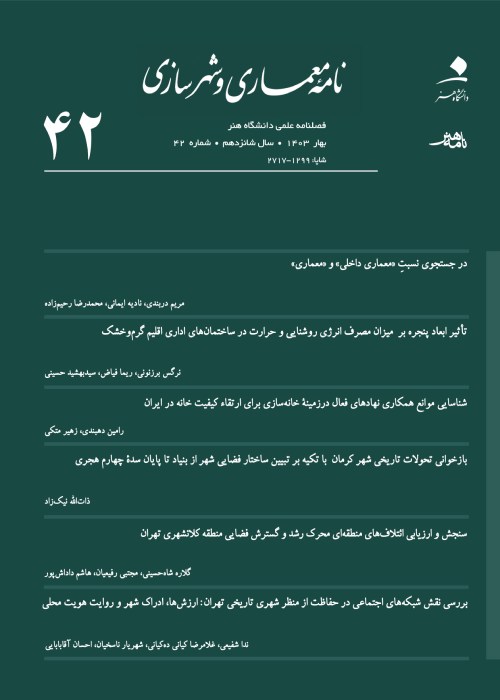A New Massing Pattern for Row Housing A Comparison Between Two Massing Types of Residential Blocks Through Thermal Comfort
Author(s):
Abstract:
Designing and planning for residential development are among significant components of any planning or urban design efforts. In many countries, residential types vary greatly between regional markets, and they vary within a single municipal jurisdiction too. Housing types acceptable in a locale may not be culturally, economically or environmentally viable even a short distance away. Among the main issues in housing practice are the housing block types. Block types refer to the arrangement of the relationships between mass and space in an individual plot and then in a whole block shape. This also depends on many various factors such as building types (e.g. single family, multifamily, detached or attached, etc.), street patterns (e.g. in case of total width), open space patterns (e.g. courtyard, back yard, etc.), environmental condition (e.g. macro and micro climatic zone, slope, scope, etc.), in which every single factor adjudicates to bring about some diverse block patterns. Therefore, the more variety of conditions needs to meet the more variety of massing patterns. In the recent half century, there has been emerged a massing pattern through the spatial transformation of house, in which the mass is placed in north side of plot and then courtyard in the south side of it. Because of prevalence of this pattern throughout the whole country and also within several decades, it can be taken as a part of planning tradition of contemporary, rural and detached urban fabrics of Iran. This article aims to survey the mentioned pattern and answer the questions which are the insufficiencies of this pattern at first. Then it studies how some changes in massing pattern could cause wide spread microclimate variations. In this case, two massing patterns have been compared. The first pattern is a current one that has been addressed before. The second is a proposed pattern which is similar to the current pattern, except in pitching, on parcel. Indeed, in the proposed massing pattern, the north plots are covered from line of plot in street proximity. Therefore the microclimatic variants which influence on thermal comfort have been compared. The microclimatic variants include mean radiant temperature, relative humidity, air temperature and wind flow (direction and speed). Envi-met model has been used to evaluate the variants. The paper is going to apply Leonardo and Xtract software’s in order to extract required outputs in terms of graphics and numeric. The findings indicate some prominent differences between the two compared patterns pro of the proposed one. Indeed, based on precise mathematical calculation, the proposed pattern has 4 levels higher than the existing one within the thermal comfort variants. Especially, in relation to the mean radiant temperature variant that is known as a critical scale to determining the comfort in exterior condition. It proves that only replacing the mass in a given plot can make great improvement on saving energy and is mainly suitable for microclimate condition. Also it poses a question for not renewing the regulatory context to bring about the better block patterns and the existing conditions have been left on its own.
Keywords:
Language:
Persian
Published:
Journal of Architecture and Urban Planning, Volume:4 Issue: 7, 2012
Page:
165
magiran.com/p1161659
دانلود و مطالعه متن این مقاله با یکی از روشهای زیر امکان پذیر است:
اشتراک شخصی
با عضویت و پرداخت آنلاین حق اشتراک یکساله به مبلغ 1,390,000ريال میتوانید 70 عنوان مطلب دانلود کنید!
اشتراک سازمانی
به کتابخانه دانشگاه یا محل کار خود پیشنهاد کنید تا اشتراک سازمانی این پایگاه را برای دسترسی نامحدود همه کاربران به متن مطالب تهیه نمایند!
توجه!
- حق عضویت دریافتی صرف حمایت از نشریات عضو و نگهداری، تکمیل و توسعه مگیران میشود.
- پرداخت حق اشتراک و دانلود مقالات اجازه بازنشر آن در سایر رسانههای چاپی و دیجیتال را به کاربر نمیدهد.
In order to view content subscription is required
Personal subscription
Subscribe magiran.com for 70 € euros via PayPal and download 70 articles during a year.
Organization subscription
Please contact us to subscribe your university or library for unlimited access!


